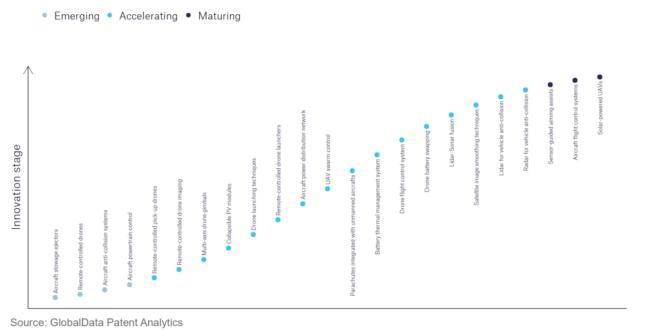The aerospace and defence industry continues to be a hotbed of innovation, with activity driven by the pressing need for modernisation and the growing importance of emerging technologies such as artificial intelligence and unmanned systems. In the last three years alone, there have been over 174,000 patents filed and granted in the aerospace and defence industry, according to GlobalData’s report on Internet of Things in Aerospace, Defence & Security: Drone flight control system.
However, not all innovations are equal and nor do they follow a constant upward trend. Instead, their evolution takes the form of an S-shaped curve that reflects their typical lifecycle from early emergence to accelerating adoption, before finally stabilising and reaching maturity.
Identifying where a particular innovation is on this journey, especially those that are in the emerging and accelerating stages, is essential for understanding their current level of adoption and the likely future trajectory and impact they will have.
180+ innovations will shape the aerospace and defence industry
According to GlobalData’s Technology Foresights, which plots the S-curve for the aerospace and defence industry using innovation intensity models built on over 262,000 patents, there are 180+ innovation areas that will shape the future of the industry.
Within the emerging innovation stage, aircraft powertrain controls, remote controlled drones, and aircraft anti-collision systems are disruptive technologies that are in the early stages of application and should be tracked closely. UAV swarm control, lidar for vehicle anti-collision, and satellite image smoothing techniques are some of the accelerating innovation areas, where adoption has been steadily increasing. Among maturing innovation areas are sensor-guided aiming assists and aircraft flight control systems, which are now well established in the industry.
Innovation S-curve for Internet of Things in the aerospace and defence industry
Drone flight control system is a key innovation area in Internet of Things
UAV requires flight control software, as well as hardware components which allow a degree of autonomous control as well as human operator control.
GlobalData’s analysis also uncovers the companies at the forefront of each innovation area and assesses the potential reach and impact of their patenting activity across different applications and geographies. According to GlobalData, there are 10+ companies, spanning technology vendors, established aerospace and defence companies, and up-and-coming start-ups engaged in the development and application of drone flight control system.
Key players in drone flight control system – a disruptive innovation in the aerospace and defence industry
‘Application diversity’ measures the number of different applications identified for each relevant patent and broadly splits companies into either ‘niche’ or ‘diversified’ innovators.
‘Geographic reach’ refers to the number of different countries each relevant patent is registered in and reflects the breadth of geographic application intended, ranging from ‘global’ to ‘local’.
SZ DJI Technology is the leading patent filer in drone flight control systems. The company makes a number of commercial drones including camera drones designed to produce high-quality images. Its miniature series of drones as well as photography drones require precise control, and this is the motivation behind filing patents in this sector. KDDI is the second largest patent filer and has consolidated its industry position by developing technology that will enable a single operator to control multiple drones at a time. The company is developing a variety of infrastructure including technology that will streamline delivery process and automate it where possible. Some other key patent filers in the drone flight control industry include NEC, Denso, Secom and Hitachi.
In terms of application diversity, KDDI is the largest company, investing in the technology to advance a variety of infrastructure. Hitachi and NEC took the second and third positions, respectively. By geographic reach, SZ DJI Technology has the top position, followed by KDDI and Technicka Univerzita V Kosiciach.
The patents in this sector largely focus on precision control, providing operators with greater capabilities when piloting drones and also enhancing the capabilities of existing drones.
To further understand how Internet of Things is disrupting the aerospace and defence industry, access GlobalData’s latest thematic research report on Thematic Research – Internet of Military Things.
 Unmanned Aerial Vehicle The latest drone news
Unmanned Aerial Vehicle The latest drone news




